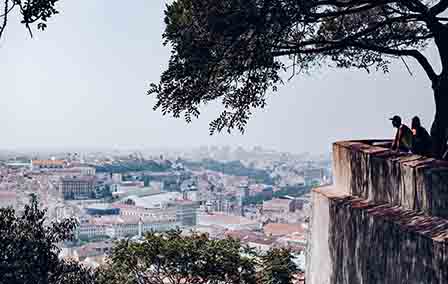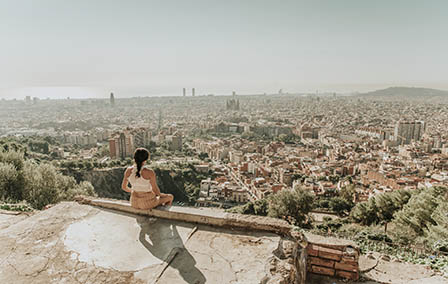Published 28th Jun. 2021
Reading time
Don't worry. This isn't a blog about the dry as dust subject of European equivalence that was a hot topic during the first round of Brexit negotiations. We're talking about something far, FAR more interesting: namely the fact that you don't need to fly to the ends of the Earth to appreciate some of the planet's finest natural phenomena, wildlife and cultural curiosities. It turns out that at almost every turn there are European equivalents that are, in most cases, every bit as jaw-dropping or fascinating. Even better, because of their relative proximity, many can be visited using a clever combination of trains, which we would be delighted to arrange.
Table Top Mountains
Don't go to Cape Town, go to... the Vercors in France.
You may recognise Nicholas Crane. He's the bespectacled walker, writer and presenter on the BBC2 series Coast who famously always hikes carrying an umbrella. So far, so British, but he also wrote a wonderful book called Clear Waters Rising about walking across Europe from the north-west tip of Spain to Istanbul along the continuous chains of mountains (Picos de Europa, Pyrenees, Alps etc) stretching across the continent. It's fair to say he's seen some fairly beautiful bits of Europe, but when asked which was his favourite, he said the Vercors region of France. Now, most French people would struggle to point out the Vercors on a map, which is one of the main reasons it remains a genuine hidden gem. That and its sheer inaccessibility, with a sheer cliff face running north-south for tens of miles. Once you're up on the table top, though, it is one of the most calming, beautiful places imaginable, home to pristine meadows of wild flowers and the occasional shepherd and flock.
Wetlands
Don't go to the Okavango Delta in Botswana, go to... the Danube Delta in Romania.
As someone lucky enough to have been to both the Okavango Delta in Botswana and the Danube Delta, Romania, I can truly say the comparison is astonishing. Sure, there's an absence of hawing hippos and elephants drinking through their trunks in this (or any other) part of Romania, but the birdlife bears comparison, with millions of birds (and over 320 different species) congregating here in May and September - some actually from the Okavango - to breed, or mid-migration in a destination now officially recognised as one of the biodiverse places on the planet.
Salt Pans
Don't go to Salar de Uyuni in Bolivia, go to... Pamukkale in Turkey.
Granted, the vast Salar Uyuni salt flats in Bolivia might be a little larger than those at Pamukkale, stretching across some 4,000 square miles, but the Bolivian pans are as flat as, well, pancakes, whereas those in Pamukkale form extraordinary terraced basins. Throw in the neighbouring Greco-Roman-era spa town of Heirapolis and this constitutes one of only a handful of mixed natural and cultural UNESCO World Heritage Sites anywhere in the world.
Glaciers
Don't go to Perito Moreno Glacier in Argentinian Patagonia, go to... the Vatnajökull Glacier, Iceland.
Like the awesome Perito Moreno Glacier in Patagonia, Vatnajökull (Europe's largest glacier) has a glacial lake at its snout, and a boat trip to peer up at the sheer wall of ice and watch detached icebergs drifting by is truly spectacular. Even better, Vatnajökull is ideal for glacier walking, both on top to get a sense of scale, and beneath, in extraordinary blue caverns through the ice.
Desert
Don't go to Arizona in the US, go to... Tabernas in Andalucia, Spain.
The so-called Spaghetti Western movies of the 60s and 70s earned their nickname because they were made in Europe by Italian directors and producers, but they could just as easily have been known as the Paella Westerns as most were actually shot in a spot in Spain. Introducing the Tabernas Desert, just over an hour from Granada, and a desert ringer for the Wild West. Combine the high culture of Granada's magnificent Alhambra - the crowning achievement of Moorish architecture in Spain - with a visit to Tabernas, where you can still visit some of the movie sets, complete with Mexican pueblos and realistic cowboy frontier towns, swinging saloon doors and all.
Polar Bears
Don't go to Churchill in Canada, go to... Svalbard in Norway.
As any Philip Pullman fan will know, the Arctic islands of the Svalbard Archipelago are home to one of the world's largest populations of polar bears, in a habitat considerably easier to reach than Canada's Churchill on the shores of Hudson Bay in deepest Manitoba. It's important to note that you can't actively head out on snowmobile tours with the express intention of finding these great white apex predators, but should you see them in the wild (as often happens), it will likely be one of the most memorable wildlife experiences you ever have.
Manta Rays
Don't go to the Maldives, go to... the Azores, Portugal.
On the subject of memorable wildlife experiences, seeing manta rays elegantly gliding around you on a dive is the stuff of bucket lists, but one more often associated with the Maldives, Indonesia or other exotic and far flung destinations. No longer, because the island idylls of the Azores in the Atlantic are home to dive sites where sightings of manta rays are all but guaranteed. If you're lucky they will even come up close because mantas often swim above you to have their tummies tickled by your bubbles.
Indigenous Peoples
Don't go to Australia, or Papua New Guinea, go to... Swedish Lapland to meet Sami herders.
We've talked about wild landscapes and wildlife, but what of meeting the local people, another huge reason we travel? Europe has that angle covered too, and one great example is the nomadic Sami people who migrate across the borders of Lapland between Sweden, Norway and Finland with their herds of reindeer seeking out new grazing grounds. Spend time with Sami families and you will learn about their millennia-old traditions, hear their myths and legends at storytelling sessions and reconnect with ancient skills such as whittling, foraging and cooking over a fire.
Dark Sky Reserves
Don't go to the Atacama Desert in Chile, go to the Alentejo, Portugal.
The Atacama Desert in Chile is famed for it's perfect stargazing conditions - namely a total absence of light pollution and the correct climatological conditions (ie: no cloud/rain) - for astronomy, hence its inclusion as one of the world's few Dark Sky Reserves, and the presence of the enormous, and enormously long-winded, Atacama Large Millimetre/submillimetre Array (ALMA) collection of radio telescopes capable of looking deep into the galaxy. Closer to home, the Alqueva region of Alentejo in Portugal was the UNESCO-recognised Starlight Foundation's first ever Starlight Tourism Destination thanks to its own perfect stargazing conditions. By day, the Alentejo is also a lovely place to ride, walk, sample under-rated wines and eat extremely well.
Want to know more about our European equivalents? Get in touch!
Practical advice and inspiration for your next trip

For a long time, the average holiday in Portugal centred around the sun-soaked beaches and manicured golf courses of the Algarve. But today, Portugal can confidently challenge Spain and Italy as the host of some of Europe’s best city breaks. The warm Mediterranean climate, rich history and culture and delicious cuisine attract millions of visitors each year, with the country enjoying record-breaking tourism revenue in 2024.
4th December 2024 - Portugal Big Short Breaks

A city of redbrick and revolution, tea parties and trails, Boston is where America’s history was made and saved. So, naturally, it’s one of the country’s favourite cities (and a top destination for US holidays). Brimming with character and cobblestones, as well as a food scene that puts seafood centre stage, Boston truly feels like a home away from home. So, whether you're a history buff, foodie, sports fan or just a traveller wanting to be surprised, Beantown has you covered.
10th November 2023 - USA Big Short Breaks

A weekend away is calling your name. But where to go? If unique character, captivating culture and delicious cuisine are on your wish list, either Rome or Barcelona could be the one. So, will you be adventuring around the ancient sites with a belly full of pasta? Or gallivanting with Gaudí from tapas bar to beach? Let’s see who takes the crown in this contest of Continental favourites. Character Culture Cuisine Live like a Local Character The centre of the Roman Empire and the capital of modern-day Italy, Rome is a captivating clash of the classical and the contemporary.
13th September 2023 - Big Short Breaks

Our team of destination experts will get to know you and your unique requirements for your holiday

We work with you to build an ultra-personalised holiday itinerary with your choice of accommodation, experiences and activities

All of our holidays include little extras designed to make a big difference to your trip, from fast-tracking you through airport check-in and security to our network of local Concierges